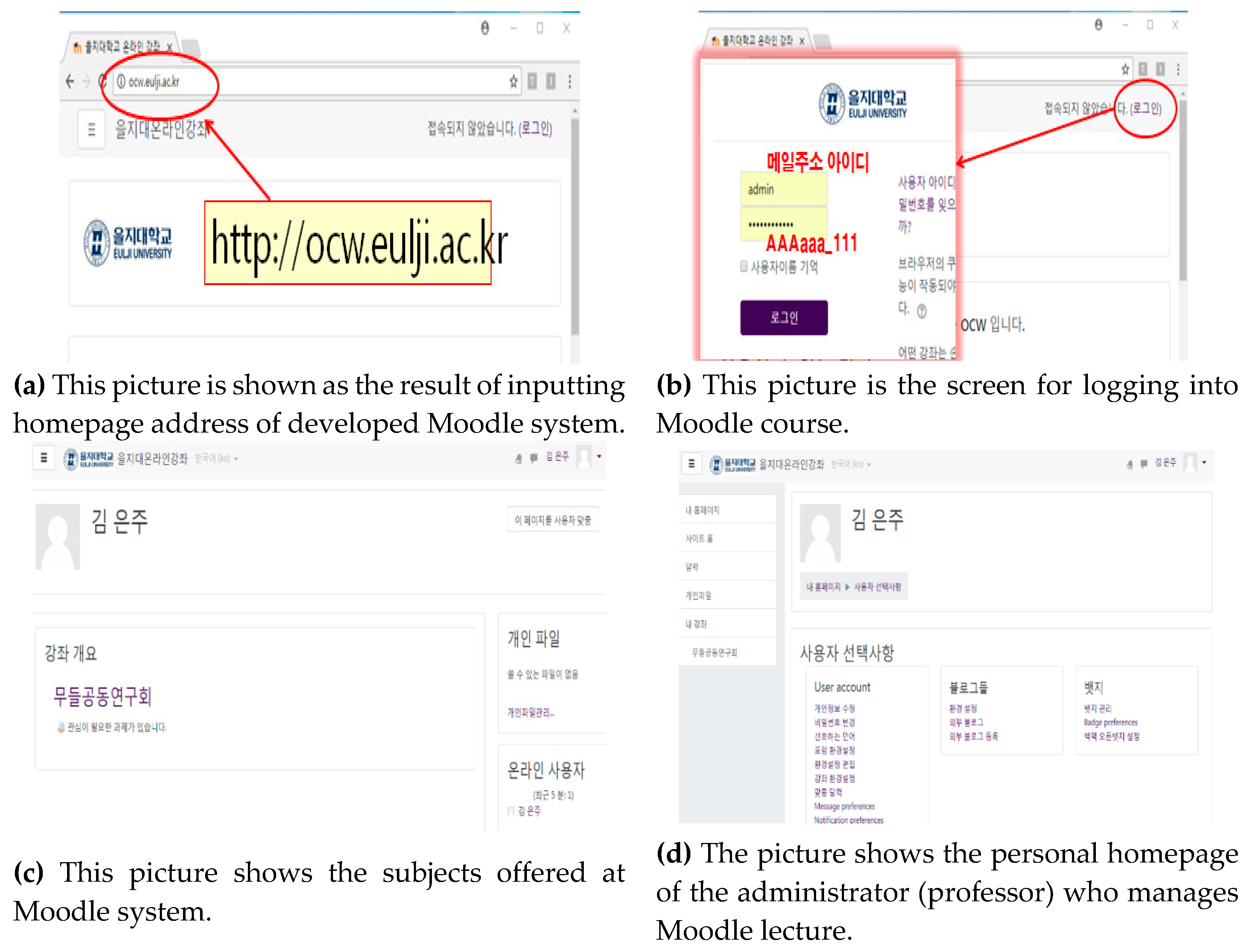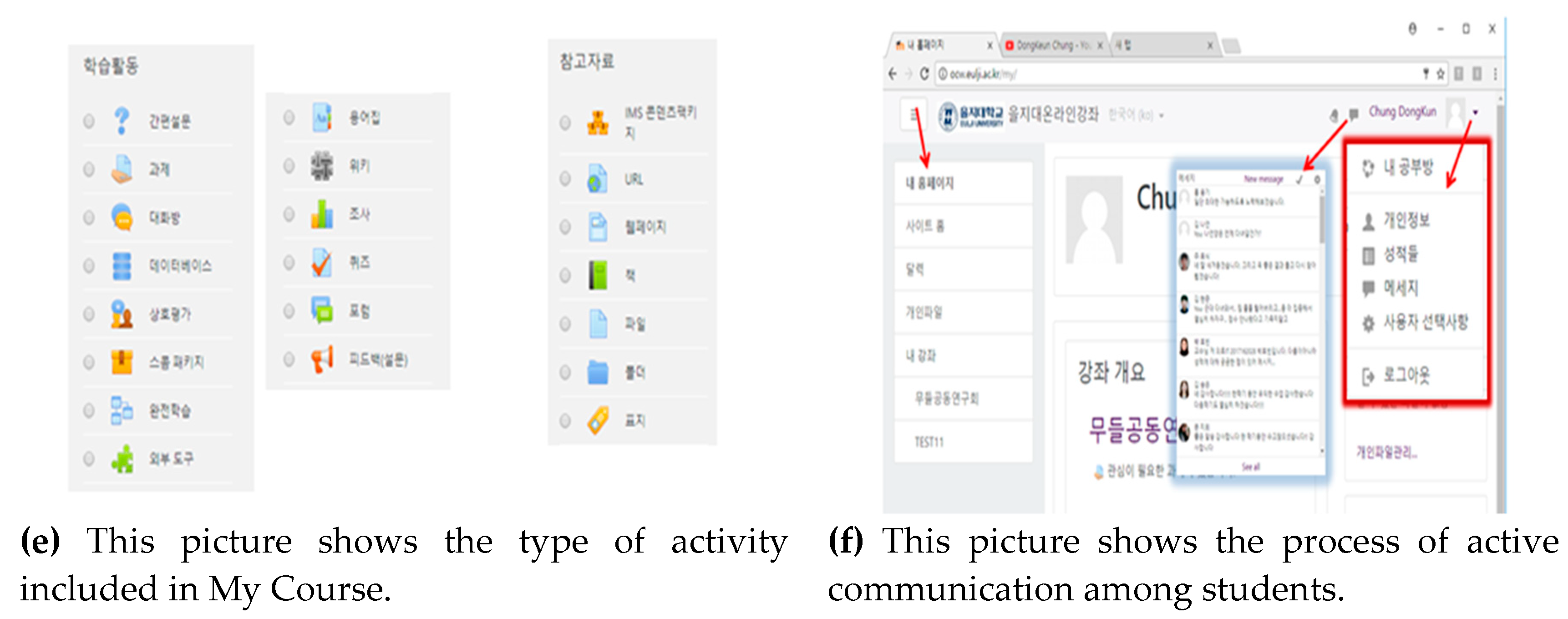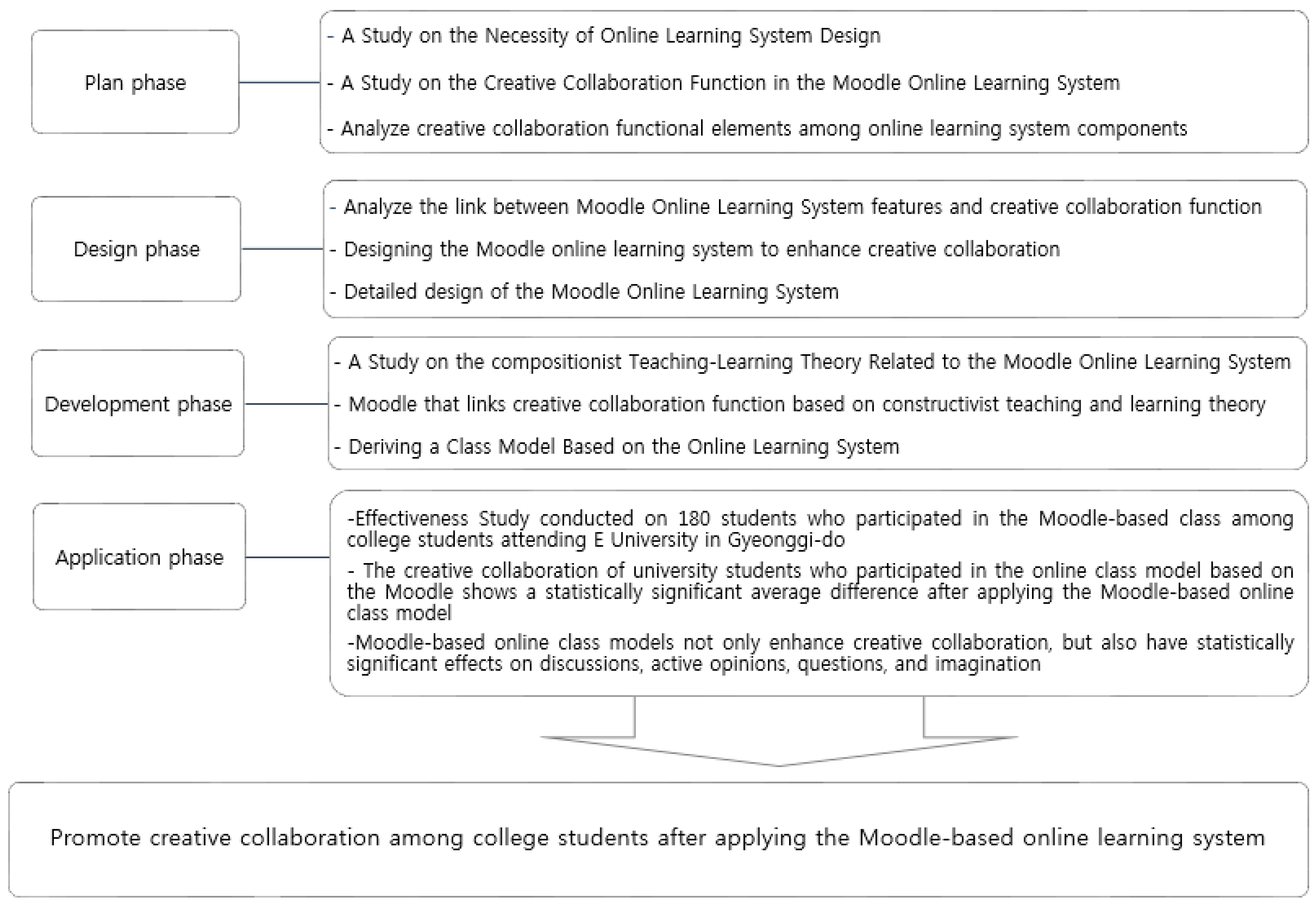1. Introduction
Recently, various online education methods using IT technology have been introduced to the field of education. However, for most online learning, system design and effect studies related to learners’ self-directed learning ability are dominant, and research on the educational method for the improvement of creative collaboration is insufficient. Creative collaboration aims to achieve creative—novel and appropriate—outcomes through sharing of creative processes between the cooperatives. It is known that creative collaboration affects creative outcomes through psychological mechanisms such as reflections-in-action, brainstorming, compaction, and interdependency [
1]. An educational method to promote this creative collaboration is the Moodle Online Learning System, which is an open-source learning system. Moodle’s learning activity tools support learning activities through mutual cooperation among members, and construct knowledge by naturally experiencing the knowledge sharing process that occurs for learners [
2,
3]. The open-source learning management system, Moodle, is useful for creating an effective online learning community. It also encourages learners to participate in the learning process and helps professors who aim to improve the learning performance of their students through creative collaboration.
The development of IT technology in the 21st century and the transformation into a knowledge and information society led to many changes, even for the field of education. In particular, E-learning education was expanded with an emphasis on innovation in the educational field, and interest in teaching methods for fostering higher spirits, such as learners’ creativity, problem-solving skills, and cooperative skills, was increased through various interactions between professors and learners, and between learners and other learners. In particular, with the shift of the education paradigm to an E-learning environment, learners are perceived as being members of a learning community pursuing common values and goals rather than beneficiaries of the teaching content delivery system. This shift also emphasizes that knowledge and experience—limited to a small number of people in the past—should not be limited to only a small number of people but should be able to be shared anytime and anywhere [
4,
5].
This shift in the educational paradigm requires a creative collaboration function as one of the necessary education methods for learners. Creative collaboration is essential to achieving that goal, which entails intensive exchange and dialogue among collaborators, control of different opinions and conflicts, and active participation in alternative decisions. If effective collaboration is not obtained, then serious conflicts occur and immature conclusions among collaborators are produced. This outcome negatively affects the creativity of the collaboration results. The study of Beckman et al. (2018) highlights collaborative teamwork through convergence between culture and arts, and business in the classroom [
6]. Creative collaboration began in the late 1970s, and the collaborative performance of tasks and knowledge sharing among group members helped to increase creativity within the team. A typical theory of creative collaboration is Osbon’s group brainstorming. Group brainstorming can enhance team creativity through the sharing of thoughts and ideas among group members in collaborative learning. This means free exchange of ideas among team members is effective in generating new ideas [
7,
8].
In order to develop a creative collaboration function for learners in the educational field, it is necessary to have an open approach to knowledge, avoid developing a general approach to that knowledge, and explore other possibilities and alternatives. It is difficult to form this type of productive attitude while conducting a professor-centered one-way lecture class in a traditional classroom. Recognizing this as a problem, in many studies, an online multi-user environment is being considered by some scholars as a tool for creative collaboration as a way to explore and solve educational methods in the online learning environment [
9]. In particular, with the development of information and communication, online learning systems are being actively developed in education sites to share information and thinking.
An online learning system is important in an educational environment that can ensure interactivity. Weigel (2002) argued that the core of online learning should be considered from the beginning of the system’s development phase so learners can have a voluntary experience on their own [
10], which basically involves an autonomous learning environment in which learners are masters, where diverse information is developed, and where learners can share knowledge and information with others, such as peer learners and professors [
11]. In addition, online learning systems can promote learners’ autonomous learning, problem-solving, and critical thinking skills. The advantages of online learning are that educational institutions have already built and operate their own online learning systems to effectively conduct web-based education. However, each educational institution has various burdens, including the costs of building the system, maintenance costs, and the costs of securing professionals with relevant knowledge and skills. Nevertheless, there is still a growing demand for the use of online learning systems in education sites. Thus, open-source online learning systems have emerged as a new alternative to meeting these needs [
4].
Overseas universities are also creating a smart learning environment through learner-led collaboration with standardized platforms and Web 2.0 learning tools. These changes, along with an interest in developing and utilizing educational open sources for joint use of content, are currently being applied to a series of platforms and online learning tools that are being used by more than 40 million people in 213 countries and more than 70 universities around the world. In addition, the product line that occupies the LMS (Learning Management System) market consists largely of Blackboard, Sakai, Desire2Learn, and eCollege. It also intends to apply a class model derived for university students and verify its effectiveness.
As such, specific research issues to achieve research purposes are as follows.
- (1)
First, which of the functions of a Moodle-based online learning system enhances creative collaboration?
- (2)
Second, what components can enhance creative collaboration in a Moodle-based online class?
- (3)
Third, is the Moodle-based class model effective in promoting creative collaboration among college students?
2. Literature Reviews
2.1. Creative Collaboration
Collaboration is a temporary relationship created to achieve a specific purpose among professionals, which is mainly used to share a workload that cannot be dealt with alone, thereby increasing productivity or reliably solving difficult problems. During this collaboration, creative collaboration aims to achieve creative, novel, and relevant results through shared creations developed by the contractors. It is known that creative collaboration affects creative outcomes through psychological mechanisms such as selection-in-action among cooperatives, production of many alternatives, reliability of alternatives through complementarity, and stability through interdependency involving interaction between the cooperators.
Beckman, Scott, and Wymore (2018) argue in their research that collaboration provides a variety of experiences for students and balances openness and resistance to change [
6]. Collaboration also emphasizes the ability to interconnect the expertise of each student. As such, collaboration can be seen to contribute to providing students with a variety of experiences and interconnecting their forms of expertise. However, students do not have many opportunities to engage in highly collaborative activities at school. In particular, for college students, collaborative activities that require a lot of time due to major learning objectives are not frequently used as teaching methods. As online learning is being strengthened, it is necessary to find ways to enhance collaboration activities through online learning.
Edmondson (2012) discussed ways to develop team building skills among students: In Collaborative Innovation, students toggled regularly between inner and other forms of focus as a way to learn about both themselves and their peers. In part, this was facilitated by an explicit focus by faculty on developing teamwork [
12]. In this way, various methods should be tested to promote interaction and collaboration among students rather than the instructional methods of professors.
In an online multi-user virtual environment, cooperatives can access a collaborative environment without restrictions of time and place, which can help students share different perspectives, or participate in alternative decisions and appropriate dialogue [
13]. Therefore, an online learning system should be established in which students can not only learn knowledge and experience from knowledge-oriented professor-learning perspectives, but also create new knowledge and information based on knowledge information gained from the knowledge base.
Based on this theoretical review of creative collaboration, Creative collaboration involves the use of psychological mechanisms such as reflection among cooperators, the production of many alternative options, the reliability of alternatives developed through mutual complementation, and stability provided through interactions between cooperators.
2.2. Moodle-Based Online Learning System
Moodle (Modular Object-Oriented Dynamic Learning Environment) is an open source LMS developed in Australia in 2002 and has been available since the 1.0 version was released in March 2011. In a cooperative learning environment that uses Moodle, anyone can become a professor or a learner. Learners can participate in collaborative learning activities such as forums, Wiki, vocabulary, databases, and messages using Moodle. These learners’ collaborative learning activities also improve the experiences of other learners. In particular, Moodle provides a number of ways to express and share the knowledge that learners possess. Moodle also provides a good tool for monitoring community learning activities. Through these collaborative activities, learners can create new knowledge on their own and further develop critical thinking and flexible creative problem-solving skills through mutual cooperation between members.
In this study, to determine the components of the Moodle Online Learning System, a prior study was analyzed as follows. First of all, discussion activities, such as forums, that are available as collaborative learning functions of the Moodle-based online learning system are effective and efficient in demonstrating creativity by facilitating the active participation of learners and providing them with new knowledge. In addition, the Wiki activity that organizes learning from discussion activities into writing and enables learner interactions with other learners increases creativity [
14].
Real-time interaction is one of the advantages of an online learning system. In online learning, real-time interactions can be active to enable creative collaboration between professors and students rather than just uploading and managing of bulletin boards and learning materials. Message functionality also provides learners with the ability to freely express opinions about the content of classes and other opinions related to learning. These Moodle-based online learning systems are based on constructivist learning theories, enabling learner-oriented classes with the expectation of increasing the creative collaboration function among multiple learners.
Moodle can be modularized among the class members, and has features that facilitate free discussion and evaluation. In particular, Moodle has several functions that help with cooperative learning, and these can be actively changed, depending on the level or purpose of the learner. Because of these advantages, it has the largest number of institutions and users in the world, based on the open-source learning system area. In addition, the flexibility of cooperative learning is a key element in the recent eLearning trend that enables collaborative learning, breaking away from the existing eLearning forms where simple questions or tasks are presented. That is, the system flexibility of the various learning processes, such as collecting individual opinions, writing documents, and meetings, is becoming a very important element in the eLearning learning model.
The Moodle-related educational theory aspect is designed to promote collaborative learning on the basis of constructivism [
4]. These examples are effectively shown in Moodle’s online learning activity menu and have the ability to post replies on bulletin boards and evaluate and recommend comments from learners to each other. In the Mutual Assessment Menu, evaluations of student interdisciplinary tasks or participation in learning activities can be made available to enhance the creative collaboration function.
Furthermore, the Moodle learning system’s blogs and Wiki make it easier for learners to create Web content and facilitates the creation of a cyber community. Using blogs and Wiki in education can facilitate learners’ self-control and active learning. Blogging enables individuals to create a global cyber community by posting and sharing their interests, writings and links with others. In addition, the forum menu also enables active learning. The Beyer (2012) study found that Wiki activity can support learners’ meta-cognition by asking questions to facilitate reflections on learning processes and outcomes [
15].
2.3. Development Environment and Procedure for Installing of the Moodle Online Learning System
In this study, the hardware environmental central processing unit (CPU) specification of the Moodle online learning system developed to enhance creative collaboration is Intel Pentium Dual 1.73 GHz and the periodic memory specification is 896 MB. With the software environment of the system, the operating system is Windows 7, the database is MySql, the web server is Apache, and the web technology is PHP. In addition, if you are installing Moodle on a Windows server, a Visual C++ redistributable file for Visual Studio 2012 must be installed at
http://www.microsoft.com/en-us/download/details.aspx?id=30679 Visual C++ (x86 or x64). The disk space on the hardware requires a minimum capacity of 5 GB to store 200 MB of Moodle code and content. Processors need 1 GHz (min), 2 GHz dual-core or higher, and 512 MB (min) or more than 1 GB of memory is recommended. These Moodle installation requirements may vary depending on the specific hardware and software combination, type of use, and type of load, and additional resources may be required for the more frequently used sites.
The procedure for installing the Moodle in these Windows operating systems is as follows: First, download and unzip the Moodle version from
https://download.moodle.org/. Second, run the Moodle installation file to register the service. Third, create mysql DB and grant the user authority. Fourth, the installation begins when you enter the Moodle server address into the web address in an internet browser. Fifth, launch an internet browser and select
http://127.0.0.1 by running an installed file to activate the Moodle site in the local environment.
5. Conclusions
In this study, a Moodle-based online learning system was developed and a class model was derived to enhance learners’ creative collaboration capabilities. In addition, the results of creative collaboration were analyzed after applying the derived class model to university students. The conclusions drawn from these findings are as follows:
First, the development of the Moodle online learning system focused on the functions of forms, real-time conversation, reciprocal evaluation, Wiki, and blogs to promote creative collaboration among college students.
Second, the class model for promoting creative collaboration based on a Moodle-based online learning system consisted of self-reflection, learner-driven learning, cooperative learning, practical tasks, and the role of the professor.
Third, after verifying the effect of application of the Moodle-based class model for university students, a positive effect was found with regard to the creative collaboration of university students. In addition, the application of the Moodle-based online class model for college students had a positive effect on improving the discussion activities, active options, active questions, and imagination, in addition to creative collaboration.
This system can provide an opportunity to improve individual decision making, problem solving, criticism, and thinking skills in solving problems by providing learning individualization and a self-directed learning environment for learners, as well as the ability to quickly explore and share the latest, and a diverse range of information that is characteristic of the web. In addition, the lack of class time and lack of mutual cooperation learning due to a large number of students can be substantially supplemented through chat rooms, bulletin boards and e-mail activities, and active and diverse experiences can be learned through asynchronous interaction with learners, fellow learners, professors, experts, and by providing diverse multimedia resources indefinitely from the traditional teaching methods.
The implications of this study are as follows: First, in order to enhance interactivity among members and increase their creative collaboration capabilities, a class model based on an online learning system should be developed. Second, in order to promote creative collaboration, learners should use online learning systems to obtain a variety of learning opportunities. Third, the outputs obtained after cooperative learning using the online learning system should be accumulated and used for performance evaluation and course evaluation at a later stage.
In order for education to be effectively conducted using the Moodle-based online learning system developed in this study to promote creative collaboration, the creative collaboration function of the developed Moodle should be able to maximize the educational effect. To do this, online learning system-based, creative, collaborative teaching methods should be applied to online teaching design. In an online learning environment, learners can take the lead in finding a variety of information, interacting with other learners in real time and non-real time, and reconfiguring their own knowledge and expression [
17,
18]. Furthermore, Ku Yang-mi et al. (2006) argue that the online learning environment helps to promote divergent thinking by giving learners the opportunity to constantly expand their thinking while freely accessing unexpected information [
19]. The online learning environment is gaining traction as a learning environment suitable for creative problem solving and collaboration, helping to generate diverse and unique ideas that can be accessed across time and space, uploaded in one’s mind, searched, reviewed, and communicated to others [
20].
However, the online learning system developed in this study was implemented by customizing and implementing packages, which may have limitations in program modification. The online learning system developed in this study is an open-source system and may be limited in the use of some functions. This study is also to develop a Moodle-based online learning system class model that can enhance creative collaboration. Further research should be conducted to accurately identify the effectiveness of education in the application of the developed class model.











